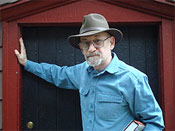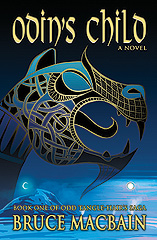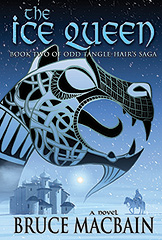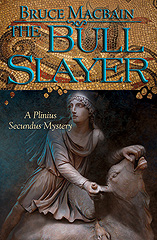In Odin’s Child (Chapter 13) young Odd Tangle-Hair and his friend Kalf
Slender-Leg leave Iceland to go a-viking with a rag-tag crew in a stolen ship.
Odd has lain hidden for many weeks in the house of Kalf’s grandfather, Hoskuld
Long-Jaws. The half-blind old man is loath to let his grandson go on this mad
adventure with Odd but Kalf insists: it is time for him to become a man.
Finally, as he and Odd are on the point of leaving, Hoskuld relents, but
lectures the boys on the ways of the wide world.
Kalf
went to embrace him, but Hoskuld held him at arm's length and bent his brows
sternly.
"Now
Kalf, you must promise me. Stay
with Odd. Never leave his side.
And mind this too, damn it all. I am not a lecturing sort of man, but there are
wise words in shriveled skins, and young dogs ought to heed ’em. You listen,
too Odd. Keep silent in a strange hall. Answer lying with lies. And don't think
that everyone who laughs when you do is your friend. When the ale goes round,
drink your share, but don't hold on to the cup. Above all, never trust what a
woman tells you or believe 'em constant, for their heads are turned on a
potter's wheel and their counsels are cold. It takes sharp wits to wander in
the world, you young dogs, and a fool is soon found out."
"Yes,
Grandfather, yes," Slender-Leg answered impatiently to all this preachy
stuff.
Hoskuld’s lecture is inspired by
a collection of verses called the Havamal,
or The Sayings of the High One. The ‘High
One’ of the title is Odin All-Father, god of poetry, warfare, and magic. In one
hundred and sixty-four short poetic stanzas Odin distills the wisdom of Viking
Age Scandinavia. The Havamal is just
one part of a larger work, the Poetic Edda,
which contains most of what we know of Sigurd and Brunhilde and all those other
legendary heroes who found their way eventually into Richard Wagner’s operas. From
such a source, then, one might expect bravado and boasting, incitement to
bloodshed and heroic sacrifice. On the
contrary, the Havamal urges caution,
moderation, common sense, and the virtues of friendship.
 |
| A page of the single surviving manuscript of the Poetic Edda (ca. 1270)
Here is a random dozen verses,
adapted from the translation by Carolyne Larrington (if you follow me on Twitter you’ll see
a new one posted every week or so.)
So, if what you want is guidance to a quiet, peaceful, and
contented life…ask a Viking!
|
Saturday, July 4, 2015
Need advice? Ask a Viking
Friday, May 29, 2015
Odin lives!: heathenism today
At the beginning of Odin’s Child, Odd Tangle-Hair, the story’s
narrator, tells us how Iceland adopted Christianity in the year one thousand. To
avoid civil war between believers in the old religion and the new Christian
converts, it was decided at the Althing that
year that one respected old chieftain would decide for all, and his
decision would be binding on all.
The
story goes that he lay for a night and a
day in his tent, his face covered with a cloak, while outside the people
waited. When, at last, he came out, he gave his verdict. Let there be one law
and one belief for all, he pronounced--and let it be the religion of the White
Christ!
Odd’s father, Black Thorvald,
alone of the chieftains, scoffed at the new faith and withdrew in fury to his distant
farm, where, as time went by, he was consumed by anger and melancholy. Odd,
whose mother was Christian, grew up torn between the two faiths. His mad father
would lead him on night-long rambles up the slopes of Mt. Hekla, declaiming the
ancient myths—and especially the myth of Ragnarok,
the doom of the gods—in a howling torrent of words.
In
the mornings [Odd
tells us] I would reason with myself, for
I am a reasoner by nature. If the gods were dead, or doomed, then why not let
them go? Why not accept the Christian god as nearly everyone did and let life
be simple? My mother believed in him, and she was a good woman.
No.
Almost..., but, no. My father's hold on me was too great for that…For his sake,
then, I thought, let these doomed gods have my prayers, for what little good it
may do them. The White Christ has all the rest.
But does the “White Christ” (as Jesus is always called in
the Icelandic sagas) still have all the rest?
Not quite, it seems—neither in Iceland nor elsewhere. The
Norse gods live on in the hearts of a growing number of devotees. Nowadays they
call the old religion “Ásatrú”—faith in the Aesir—a term invented in the
nineteenth century at the beginning of the neo-pagan revival. Now in Reykjavik
construction has begun on the first new temple to Odin, Thor and Frigg to be
built in Iceland in a thousand years. It will be a
huge, cavernous space excavated into a hillside above the city and, when
finished, will be available for weddings, naming ceremonies, and heathen
holiday celebrations. Below, is the architect's plan for the temple and a group of contemporary heathens in Iceland.
I am not a pagan myself, but as one who has studied and
written about ancient polytheism, both Greco-Roman and Norse, I wanted to understand what motivates moderns who, like Odd Tangle-Hair, reject
Christianity in favor of an older belief. Browsing Google Plus and Facebook, I
discovered more than a dozen groups that advocate Ásatrú, totaling nearly
20,000 members if you add them all up (although I’m sure there is a good deal
of overlap).
I posted a query to all of them, beginning “What drew you to
paganism?” I received quite a few replies. Many of them began by first pointing
out my error in terminology: the preferred term for believers in the Germanic
gods is “heathen”, not “pagan.”
To quote briefly from some of the respondents:
“Myself, I grew up in an LDS (aka Mormon)
house. That never really
worked for me…I finally came to the conclusion that the Norse Gods and
Goddesses were calling me…”
worked for me…I finally came to the conclusion that the Norse Gods and
Goddesses were calling me…”
“I feel the spirit of the
world, the universe, coursing with energy through my spirit and soul.”
“I was drawn to it
following my awakening out of Christianity and historical study with references
from my Northern European ancestry.”
“…it's much more insightful [than Christianity] on how
one should live and treat others.”
“…we can once again live as our ancestors did and
continue a path of existence that will very well take us into a higher state of
being…”
“I have always loved nature and adventure since I was a
kid and this has been key in my embracing of old Nordic thought.”
“I get more of a personal connection to it than I ever
did with Christianity, with Norse heathenry/ paganism I get a feeling of being
connected to the past…”
“It wasn't until I felt safe enough to break away from
the Church that I realized I was right all along and the Mary persona was
created to conceal the worship of a very real goddess.”
“When I found Ásatrú, that's when the biggest puzzle
pieces started popping up everywhere and even fit.”
“I was being groomed to be a Pentecostal pastor. I left
because everyone was a hypocrite and wouldn’t hear it if you called them out.”
“Basically, it was a feeling of being connected to the
past and feeling closer to my Celtic and German ancestry.”
“The Gods are
real. That's why.”
The themes that stand out are that heathenism is natural,
ancient, ancestral, and more personally fulfilling than whatever faith the
convert was brought up in. What is actually believed varies, as with any
religion, from a literal belief in One-Eyed Odin and Red-Bearded Thor, to
something just vaguely ‘spiritual’. (There
can be, of course, an unpleasant side to this too, where mystical “folkishness”
shades into Aryan racism. But this is decried by almost all.)
If its presence on the Internet is any indication, Ásatrú is thriving and
growing. A website called The Wild Hunt,
is one of the most active voices in disseminating heathen news and advocating
for heathen causes. A recent article highlighted a pagan lawyer who is fighting
the Keystone XL pipeline in the name of “protecting the earth and its
creatures”. Another piece discusses the
campaign to get paganism recognized as a religion by the U. S. Army.
How would Odd Tangle-Hair have felt about all this if we
could bring him back to life? I like to think he would be pleased.
Saturday, May 16, 2015
Saddle Sores: my day on an Icelandic horse
In Odin’s Child (chapter one) Odd
Tangle-Hair and his brother bring their black stallion to a horse fight—a
popular entertainment among Viking-age Icelanders.
Ahead
of us a crowd was gathered for the horse fights. We worked our way to the front
until the clearing lay before us, a haze of dust hanging over the trampled
grass. At the edge of it the mares were tethered, while in the center two
farmers, stripped to the waist and backed by a knot of shouting friends, shoved
and goaded their snorting stallions into battle. It was a good match and we
watched, shouting with the rest, until the loser, foam-flecked and streaked
with blood, charged into the crowd, scattering spectators to right and left.
Winning horse and master both threw back their heads and cried victory.
In
the days before the White Christ came to Iceland, the winning horse would have
been sacrificed to Frey, whose horse's prick fertilizes the fields, and the
meat cut up and sold to the folk to eat. Christian priests had soon put a stop
to that, but they were too shrewd to make us give up our sport entirely.
But if, reading this, you visualized
a pair of huge animals such as Medieval knights rode to battle on, you would be
quite wrong. The Icelandic horse is a short-legged, sturdy animal that stands
only about 13 hands—that is, fifty-two inches—high. Technically, it’s a pony,
although no Icelander would dream of calling it that.
Icelanders love their horses
and go to extraordinary lengths to protect them. No other breed of horse can be
imported into the country and, if an Icelandic horse is exported, it can never
come back, for fear of bringing disease with it. The Icelandic language, it is
said, has over a hundred words for the varieties of color and pattern of their
coats. The horse plays a part in Norse mythology. Odin rode an eight-legged
horse named Sleipnir and the hero Sigurd rode one named Grani, after whom Odd
names his horse.
When I visited
Iceland, I convinced myself that if a writer is setting his story in a period
where people traveled on horseback, then you have to do that in order to get a realistic feel for how long it takes, and
how hard it is, to get anywhere. Riding in a car just gives you no sense of
that at all. I hadn’t been on horse since I was probably twelve years old but I
was sure it would all come back to me. There are a number of stables in the
Reykjavik area that organize horseback treks; I signed up at Ishestar for the all-day trek—a morning and afternoon session,
punctuated by a delicious lunch (price included) of all the roast lamb you
could eat. By the time I was through with lunch I would have happily called it
a day. But no, I was committed, so I mounted up again.
Riding one of
these horses is a bit different from what I remembered from my boyhood. For one
thing, you don’t neck-rein them, as I was taught to do. Also, an Icelandic
horse uniquely has two extra gaits besides the usual three (sort of like having
two extra gears on a car), although I’m not sure I really found them. And we
did it all: we saddled and unsaddled the horses twice, rode uphill and down,
crossed streams, galloped along winding tracks through the spectacular scenery
of south-western Iceland. Did I fall off? No. Did I almost fall off? Yes, two
or three times. Could I walk when it was over? Barely.
But did I
experience the contours and texture of the land as one of those hard-bitten
warriors of a thousand years ago would have? Absolutely. And it was worth it.
Words and Pictures: reviving the illustrated novel
Once upon a time—long
before the term “graphic novel” was coined—novels written for adults and
young adults came with pictures. It began with Dickens’ Pickwick Papers (1836), whose illustrations did much to popularize
the book. Thereafter, all of Dickens’ novels were illustrated, as were those of
Sir Walter Scott, Arthur Conan Doyle, Robert Louis Stevenson, H. Rider Haggard, Victor Hugo, and Jules
Verne, just to name a few. A novel—at least, an adventure novel—without
pictures was something incomplete. Artists used engraving, etching,
lithography, mezzotint, and a variety of other processes to create
illustrations that complemented the text.
This golden
age lasted for about a hundred years. Toward the end of it, two great American
illustrators dominated the field: Howard Pyle (d. 1911), who illustrated The
Merry Adventures of Robin Hood and Men
of Iron, and his student, N. C. Wyeth (d. 1945), whose illustrations
for Treasure Island must still be
impressed on every boy’s imagination.
What put an
end to this grand tradition? Possibly competition from the movies, or the
invention of the modern comic book; certainly, the economics of the publishing
industry.
Time, we say,
to bring it back! “We” being me, and my illustrator, Anthony Macbain,
and our very enlightened publisher, Kristina Blank Makansi of Blank Slate Press. Odin’s Child has five
full-page illustrations, and we are planning for more of them in The Ice Queen and The Guardsman.
We hope
readers will approve. And—who knows?—we may be helping to bring back an old and
honored custom.
Monday, April 20, 2015
Weak Knees:or, my adventures on Iceland's Mt. Hekla
In Odin’s Child (chapter
three), young Odd Tangle-Hair follows
his half-crazed father, Black Thorvald, up the slope of Mount Hekla, which
looms above their Iceland farm. Thorvald is seeking peace from the demons that
haunt him by communing with his dead ancestors, who live in the volcano’s fiery
depths.
We
had tramped for miles now [Odd tells us]and the ground was beginning to rise
and leave the mist behind. A hundred paces ahead of me I could see his back
bent over double as he toiled upward. I scrambled after him, my feet slipping
on the loose pumice stones and the fractured lava rocks with edges like knives.
I called his name but he went on as though he didn’t hear… Hours passed. Now I
had come as far as the snow-filled crevices that reached like skeleton fingers
down the blue-black mountainside. The going was very steep as I neared the top.
My palms and knees were bloody. An icy wind tore at my clothes and wailed in my
ears like the shrieking of ghosts…
All true, except for the icy wind. It
was actually warm on the day I made my assault on Mt. Hekla.
Two summers ago I and my wife
and sons visited Iceland—a country that I have been studying and fantasizing
about as I worked on Odd Tangle-Hair’s
Saga—and I resolved to confront this mountain of my imagination.
Mt. Hekla is about five
thousand feet high—taller than Vesuvius but not nearly as tall as Mauna Kea. It
is still very much a live volcano, and in the Middle Ages was believed to be a
gateway to Hell.
I’d made it about half way up,
after two exhausting hours of slipping on loose pumice stone, sliding into shallow
snow banks, and lagging farther and farther behind the group. Finally, my
guide, a very sweet young woman, whose name I no longer remember, gently
suggested that maybe I’d gone as far as I could. Reluctantly, I agreed. Anthony
and the others went on ahead, while she guided me back down the slope—gripping
my hand the whole way and chatting to me in excellent English.
The others would not be back
for hours. In the meantime, she took me in their little tour van over miles of
washboard roads to the site of a reconstructed Viking long house: something I
would have missed otherwise. So all ended well.
Anthony told me later that I
hadn’t really missed much. There was no pit of bubbling lava at the top, as far
as he could tell, and visibility was poor, so there wasn’t much to be seen from
the summit. Nevertheless, I am grateful for the experience, although the Hekla
I describe in my novel is still mostly the Hekla of my imagination.
And I now own a pair of mountaineering pants from
L. L. Bean made of wool about a quarter of an inch thick. I wore them again for
the first time this February, during our brutal Massachusetts winter.
So, no experience is ever
wasted.
Sunday, April 12, 2015
Why do I write about Vikings? Prince Valiant in the Golden Age of Comics
I was trained as a Classicist, my
two previous novels are set in ancient Rome, I love the Mediterranean, I hate
ice and snow and suffer through Boston winters with gritted teeth. How then do
I happen to be writing about Viking Age Iceland in my latest novel, Odin's Child?
It all goes
back to Prince Valiant in the Days of
King Arthur, that wonderful comic strip written and drawn by Hal Foster from 1937 until the mid-1970’s.
On any
Sunday morning of my youth you would have found me lying on the living room rug
with the comic section of the New York Journal
American spread open before me. It must have been a dozen pages thick, or
so it seems to me now. Those of you too young to remember the golden age of
comics have no idea what you’re missing. Let me just recite the names. Flash Gordon, Tarzan, The Phantom, Terry and the Pirates, Blondie, Lil’ Abner, Dick Tracy, Joe Palooka, Barney Google, Smokey Stover…and
I could go on, but a tear is coming to my eye. What a loss that we don’t have
these anymore, or anything to compare with them!
Above them all, though, was Prince
Valiant. He had a page boy haircut, smooth cheeks, an ageless face; he lived in
Ultima Thule with his blond wife, Queen Aleta, and a whole cast of Vikings and
Arthurian knights. He fought barbarians, and occasionally dragons (though these
appeared less often as the strip aged). Yes, it was all silly—but the art work!
Foster was an amazing draftsman. No one could render castles or misty vistas
or storms at sea or swirling battle scenes the way he could in those big panel
illustrations. You could (and I did) spend long minutes studying every small
detail of them, drawn into the world he created.
Subscribe to:
Posts (Atom)













